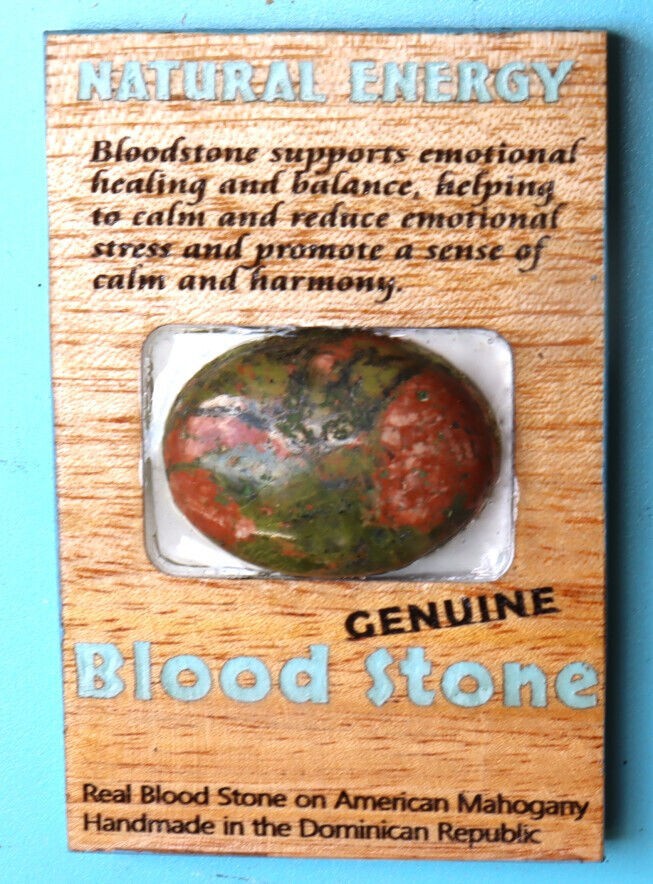Refridgerator Blood Stone spiritual Cabochon on a Mahogany Wood Base 3x2 inch For Sale

When you click on links to various merchants on this site and make a purchase, this can result in this site earning a commission. Affiliate programs and affiliations include, but are not limited to, the eBay Partner Network.
Refridgerator Blood Stone spiritual Cabochon on a Mahogany Wood Base 3x2 inch:
$26.00
Refrigerator Blood Stone Cabochon on a Mahogany Wood Base 3x2 inchFridge Magnet
- Size: 3 x 2 inch
- Base Material: American Mahogany Wood
- Stone: Blood Stone
- Origin: India
They became tiny works of art that put a smile on people\'s faces every time they reached for a snack or left a note on the fridge.
Families gathered around the refrigerator, showing off their favorite magnets and telling stories inspired by their designs.
Origin:
The origin of Labradorite can be traced to multiple locations around the world. Labradorite is a feldspar mineral that exhibits a unique play of colors known as labradorescence. Here are some notable sources of Labradorite:
- Canada: Labradorite gets its name from the Labrador region of Canada, where it was first discovered in the late 18th century. Labradorite deposits can be found in areas such as Labrador, Newfoundland, and Quebec. The Canadian Labradorite is highly prized for its vibrant labradorescence.
- Madagascar: Madagascar is a significant source of Labradorite. The country produces high-quality Labradorite with intense and vivid labradorescent colors. The Labradorite from Madagascar is known for its blue, green, and golden flashes.
- Finland: Finland is renowned for its Spectrolite variety of Labradorite. The Spectrolite from Finland is characterized by its vibrant range of colors, including blues, greens, and golds. The Ylämaa region in Finland is particularly famous for its Spectrolite deposits.
- Russia: Russia is another country known for its Labradorite deposits. The Kola Peninsula in Russia is a notable source of Labradorite, with specimens displaying a range of colors and strong labradorescence. The Russian Labradorite is often referred to as \"Black Moonstone\" due to its dark body color.
- Australia: Labradorite can be found in various parts of Australia, including New South Wales, Queensland, and Western Australia. The Labradorite from Australia tends to display predominantly blue or green labradorescent colors.
- United States: Labradorite deposits can be found in several states within the United States, including Oregon, New York, and Maine. The Labradorite from Oregon, known as Oregon Sunstone, often exhibits a unique coppery-red or peach-colored labradorescence.
- Other Sources: Labradorite is also found in other countries such as Mexico, Norway, Italy, and Ukraine. Each location may have its own unique characteristics and color variations.
These are just a few examples of the origins of Labradorite. It is important to note that Labradorite can be found in other countries as well, and its occurrence is not limited to the locations mentioned above.
Properties:
Labradorite is a fascinating gemstone known for its unique optical properties and beautiful appearance. Here are some of the notable properties of One of the most distinct properties of Labradorite is its labradorescence, which is a captivating play of colors that can range from blues and greens to golds and purples. This phenomenon is caused by the interference of light within the stone\'s internal structures, resulting in a captivating display of iridescence and color shifts as the stone is viewed from different angles.
These are just some of the properties that make Labradorite a unique and sought-after gemstone. Its mesmerizing play of colors and metaphysical associations contribute to its popularity in jewelry and spiritual practices.
Please note that while gemstones like Labradorite are believed to possess certain metaphysical properties, their effectiveness may vary depending on individual beliefs and experiences.

Related Items:
Refridgerator Blood Stone spiritual Cabochon on a Mahogany Wood Base 3x2 inch
$26.00

